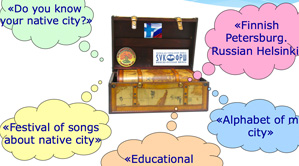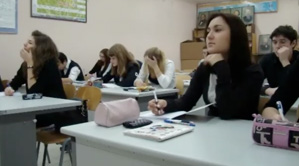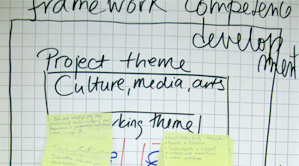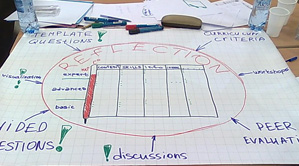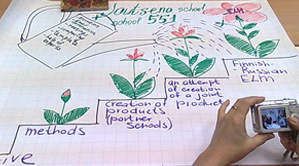Selecting themes for digital learning materials and creating a narrative for change with strategic focus
Select a project theme that serves the students, teachers and the development of the whole school.
Use Template 1 Project Visiting Card to plan your project theme.
Read more:
Focus on school development
Consider Six Ps Guiding questions
Participative
- Engaging the whole school
- Dialogue and co-operation
- Collective activity
Pedagogical use of ICT
1) How is this project linked to the development plan of your school?
2) How does it link to other T-S-L development activities in your school?
3) How is this project linked to the curriculum?
Flexible pedagogical framework
1) How do you encourage other teachers of your school to participate in this development process?
2) How do you inform about your e-material development process within your school?
3) How do you inform about it beyond your school?
Making the T-S-L culture and process visible
1) How do you organize the documentation between you and your partner school?
2) How and where do you share the documentation?
3) How do you engage your students to participate in the e-material development process?
Developing thematic digital learning material (DLM) frameworks
Create sustainable DLM to be used in different solutions, in which teachers can have a personal responsibility in making educational decisions.
Start by listing ideas of different situations, in which teachers can support and enhance the active and independent work of students using ICT. Discover the needs of the teachers and/or students: working in classrooms, distance learning, independent and collaborative learning etc.
Read more:
Focus on framework
Consider Six Ps Guiding questions
Polycultural
- Culture and context sensitivity
- Long-term partnerships
- Future-orientation
Pedagogical use of ICT
1) What basic differences do you find in your curricula?
2) What is the role of ICT in your curriculum?
3) How is it implemented in your school?
4) Is there anything you would like to do differently now or in the future?
Flexible pedagogical framework
1) Is there a specific pedagogical model you are supposed to follow or are following?
2) Is there anything you would like to do differently now or in the future?
Making the T-S-L culture and process visible
1) What are the current evaluation and assessment practices in your country and your school?
2) Is there anything you would like to do differently now or in the future?
Preparing work plan for digital learning material design and preparation process
First of all: invest in this process collaboratively. Document your way in Template 1 Project Visiting Card.
Prepare also a work plan for DLM design and preparation. Get help from questions and topics in Template 2 Digital learning material/resource design process.
To support and guide the stage-wise evaluation, reflection and documentation get familiar with the six guiding principles as an integrated process-product assessment framework for systematic quality assurance.
Read more:
Focus on process
Consider Six Ps Guiding questions
Polycultural
- Culture and context sensitivity
- Long-term partnerships
- Future-orientation
Pedagogical use of ICT
1) How do you ensure that the contents of the resource and the ways it is used
- recognize and build upon cultural foundations (traditions, values), and
- increase cultural awareness (knowledge, skills, dispositions, attitudes) at the student, teacher and school level?
2) What kind of new cultural experiences does it provide?
Flexible pedagogical framework
1) How can the e-resource and the ways it is used connect the school, teachers and students more closely to the world of art and culture?
2) How does it
- enhance cultural expression (music, performing arts, literature, and the visual arts) and sharing of ideas, experiences and emotions?
- help students, teachers and the school to reflect on differences and similarities in cultural traditions, and behaviour in general or in specific contexts and situations?
Making the T-S-L culture and process visible
1) What are the social and cultural issues or concerns you need to take into account when developing contents and tasks and when choosing technologies, methods of work and forms of pedagogical interaction?
2) How does the e-resource allow students, teachers and the school to document and monitor their cultural experiences, their progress in cultural and intercultural understanding, and their ability to cope with new situations?
3) How will they know they have made progress? What are the essential indicators?
